Disclosure: Meeple Mountain received a free copy of this product in exchange for an honest, unbiased review. This review is not intended to be an endorsement.
“So what’s Calico about?”
“It’s a game about making the most comfortable quilt so that you can attract cats to lay on it.”
“…”
“And if you put at least 3 patches in a row of the same color, you get buttons. Some of the buttons are in the shapes of mushrooms, blueberries, flowers, or leaves.”
“…”
“Did I mention it has cats in it?”
It’s plain as the whiskers on your cat’s face that we’re in a board gaming renaissance, especially when you notice that there’s a game for just about any theme, including multiple games about making patchwork quilts. And that’s where Calico comes in. The newest title from Flatout Games brings together some of the minds who brought you Point Salad (Molly Johnson, Robert Melvin, and Shawn Stankewich) with designer Kevin Russ and illustrator Beth Sobel to produce a gorgeous and delightfully puzzly game about making comfortable quilts for your feline friends. And at the risk of letting the cat out of the bag, it’s both charming and more than a little challenging.
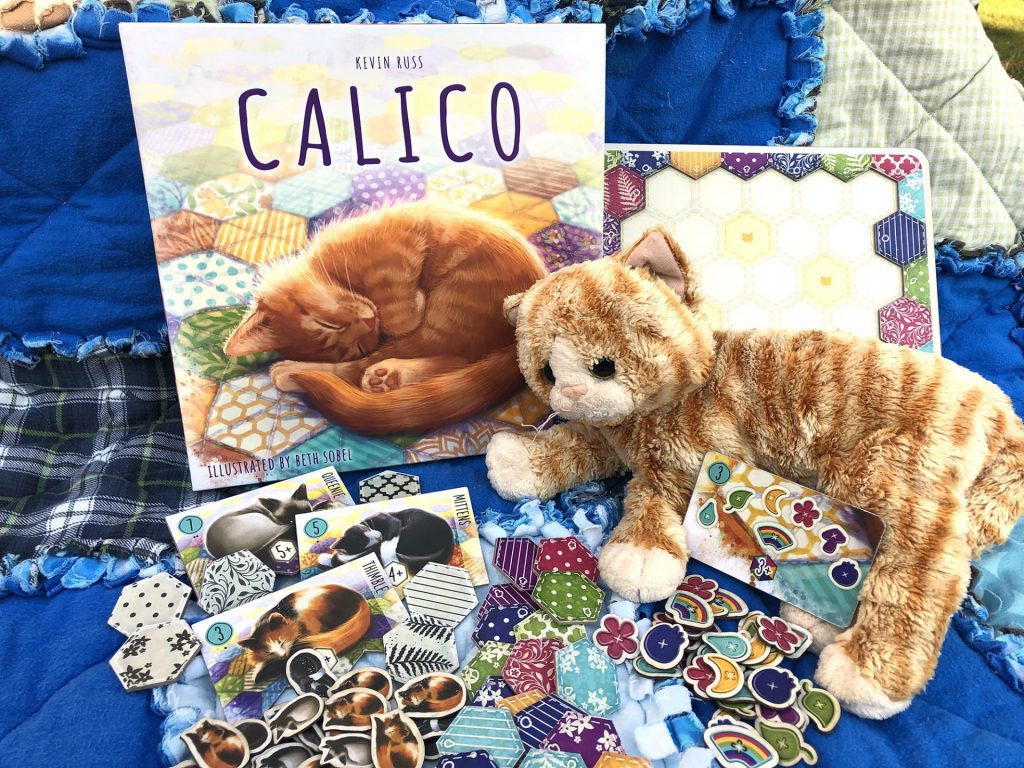
Join me as I take a look at Calico!
Calico Overview
In Calico 1-4 players play hexagonal patchwork tiles to their personal player board in order to attract nearby lounging kitties to their nascent quilt. Each tile features one of six different colors and patterns. Players place these tiles in color groups to get button tokens (3 points each) or in pattern groups to attract one of three cat tokens (3-11 points each). Additionally there are three different goal tiles in each game and if by game’s end players can fulfill their placement requirements, they will score those points as well. The player with the most points at the end of the game wins…and gets to snuggle with the cat of their choice!
Calico Setup & Gameplay
To set up Calico, give each person a player board and the matching colored goal tiles. There are 6 different goal tiles which give Calico some in-game scoring variety. The rules suggest that for your first game players each use the AAA-BBB, AA-BB-CC, and ≠ goal tiles, placing them in the same location on each board.
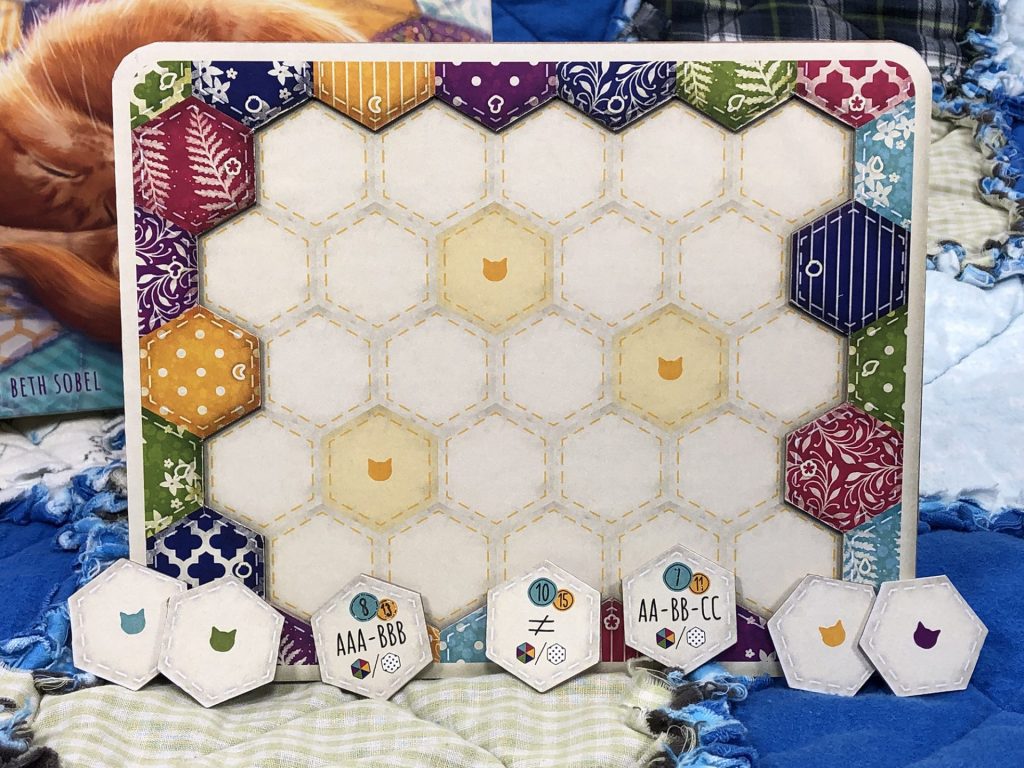
Select the Thimble, Mittens, and Queenie sides of the three cat scoring tiles (in subsequent games feel free to use whichever sides you like). Mix up the 6 black and white pattern tiles and place 2 underneath each cat scoring tile. Collect all of the cat tokens and group them by cat, placing them near the matching cat scoring tile. Each cat token will earn a different amount of points for players who meet the criteria on a cat scoring tile. The tiles under each cat dictate which patterns players must use to meet those criteria.
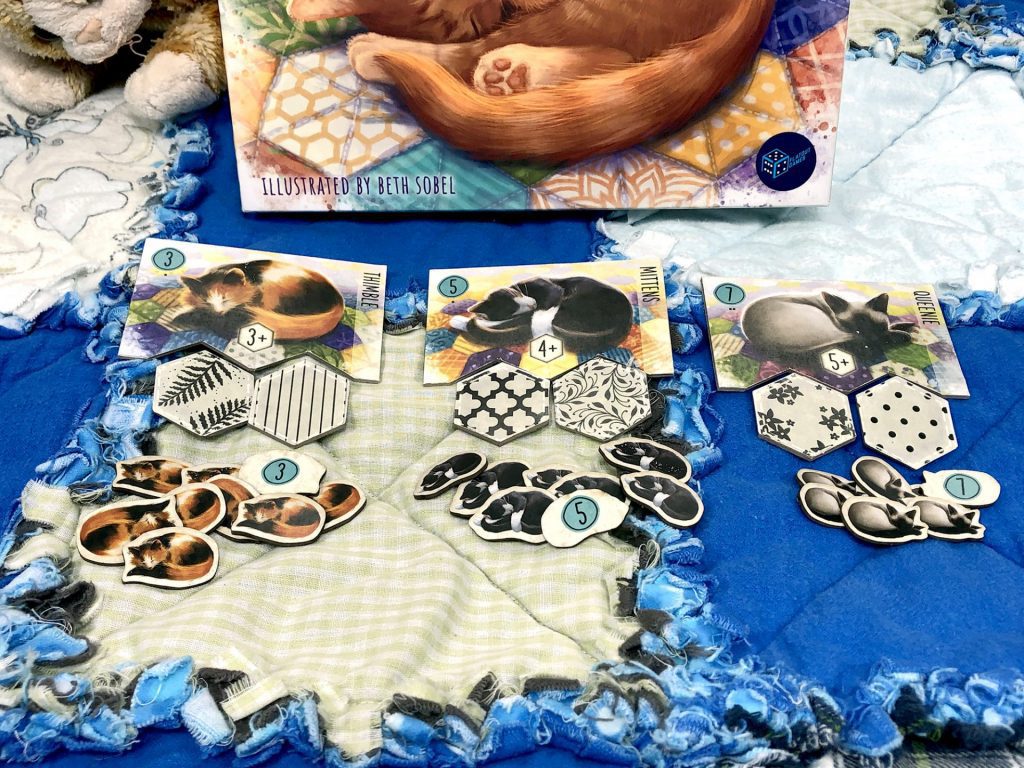
Place the button tokens and the button scoring tile nearby.
Mix up the patch tiles and turn them face-down into several piles. Have each player select two patch tiles for their hand, then reveal three patch tiles to form the draw pile.
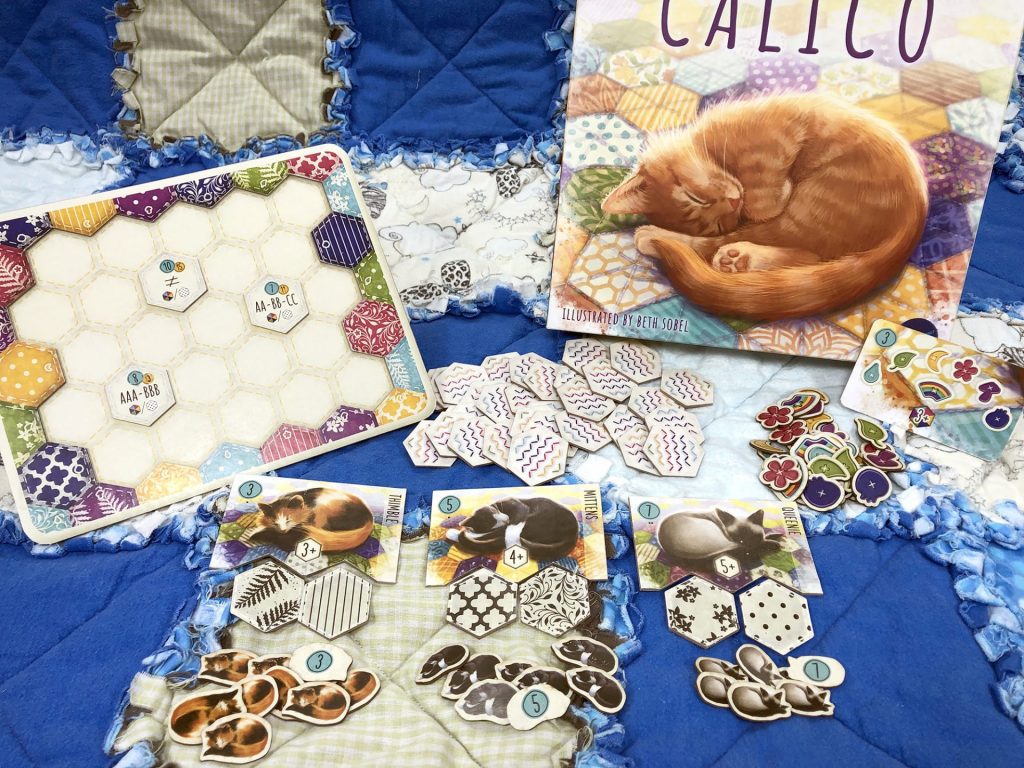
Player Turns in Calico
Players start their turn by placing a tile from their hand. There’s no restriction on where to place tiles, but remember that the main source of points will come from placing tiles in groups of colors or patterns. After placing the tile, players determine if they’ve earned a button token (groups of 3 or more same colored patch tiles), or a cat token (pattern tiles meeting the criteria on the three cat scoring tiles). Finally players draw one of the three face-up patch tiles into their hand, replacing it with a patch tile drawn from one of the face-down stacks. Turns continue until each player’s quilt is complete, at which time final scoring happens.
Goal Tiles
Each player has the same set of 6 different goal tiles (of which only three are used per game), color-coded to match their player board. Each goal tile offers two scoring opportunities: matching colors or patterns, with the face of each goal tile indicating the requirements. For example, the AA-BB-CC goal tile requires that players have only three different colors, or three different patterns, directly adjacent to the goal tile. If they accomplish that, they’ll earn 7 points for either. If however they’re fortunate enough to match both color and patterns, they’ll earn 11 points instead. Calico offers 20 different combinations of goal tiles giving games a different feel based on the specific combos.
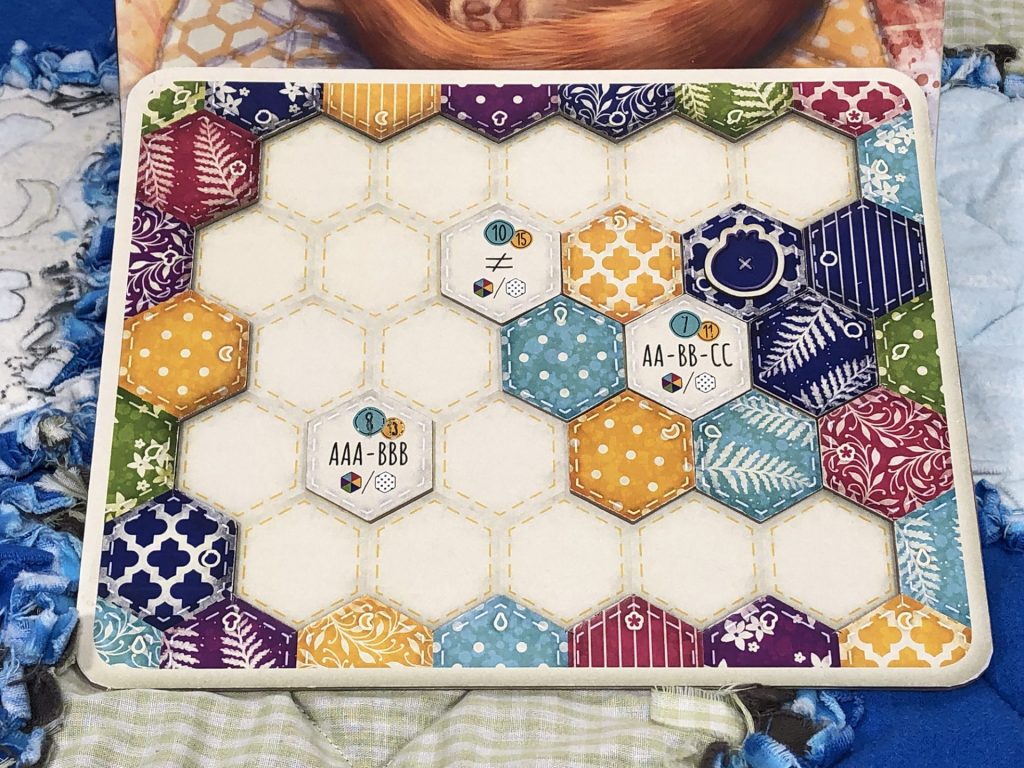
Cat Scoring Tiles
Cat scoring tiles are double-sided and give Calico some additional setup variety. One side allows players to earn a cat token for groups of matching pattern tiles, while the other side requires those tiles to be in specific arrangements.

End of Game Scoring
End game scoring in Calico is usually quite straightforward. Because tiles are placed onto the quilts during the game, it’s a simple matter of removing them from the quilt and adding them up. I find that it’s also a good idea for each player to paws to review their board before removing all of their scoring tiles as it can be easy to overlook a scoring group.
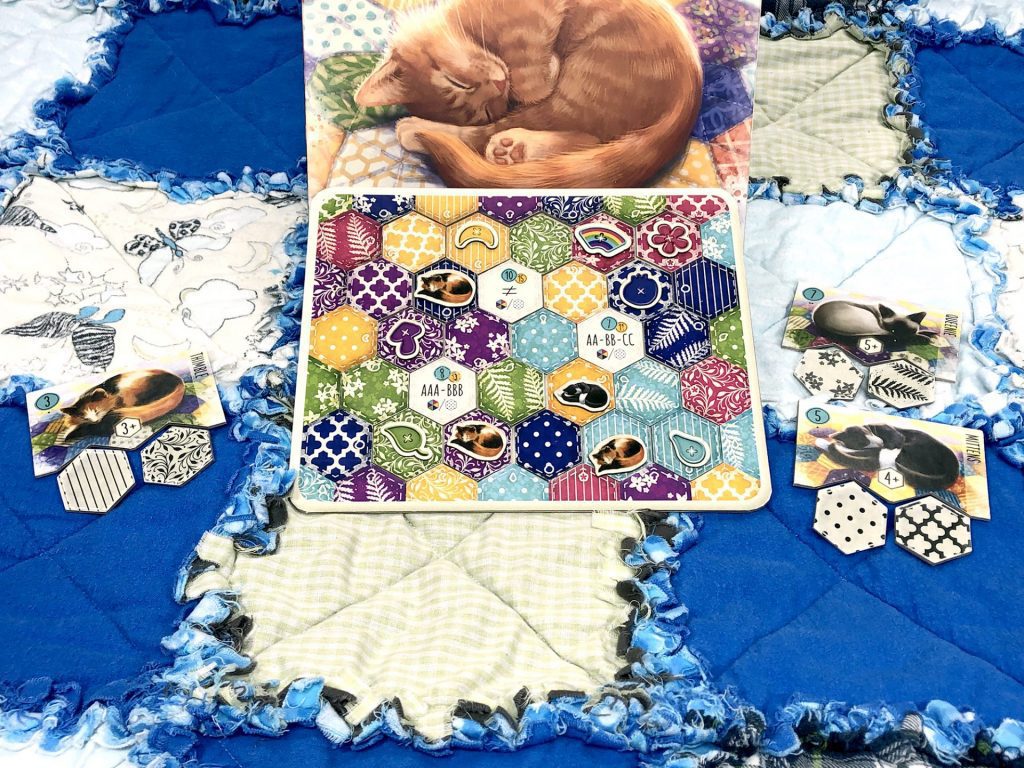
After all of the tokens have been removed and tallied, the player with the highest point total wins the game.
Final Thoughts on Calico
I’ll be honest: when I first looked at Calico I wasn’t sure what to expect. The soft colors and sun-drenched artwork from Beth Sobel mellowed me out, and the theme teased me into thinking this was going to be just another pretty face. But Calico turned out to be anything but relaxing; let me tell you that this kitty has claws. Like Scarabya and NMBR 9, Calico is largely a solitaire tile-laying game with very little in the way of player interaction. Observant players might be able to seize opportunities to claim tiles which are beneficial to their opponents, but that’s about it.
But no, the real teeth of this game is the placement itself. Your first few tiles will likely give you the chance to grab buttons by making a color group match, or perhaps a matching cat token if your first draws were lucky. But the more tiles you place, the deeper the claws sink, until halfway through the game you’re begging Bastet (the Egyptian god of cats) for any green tile, or a yellow tile with a polka dot pattern.
Calico is surprisingly challenging as players are constantly forced to think along the parallel axes of color and pattern. Before my first game, looking at the player board with only the goal tiles to guide me, I assumed that I would easily get all of the goal tiles, and potentially at least one double goal.
Let me tell you, reader: I was mistaken.
In the few games I’ve played, I haven’t seen anyone achieve both color and pattern portions of a goal tile, and in most cases every player misses at least one goal tile because of a missed opportunity. Remember that you have to place something every turn, whether it’s the right tile or not. That means you’re often forced to pick the best of two bad choices. But you never know, that perfect tile might show up…only to get grabbed by another player.
Because this is a prototype I can’t comment on these specific components, but I can tell you how hard the team worked to produce the copy that I was given to review. Let me just share some of their effort with you.
Cutting out some cats.#Calico… Coming soon! pic.twitter.com/xWL7hBOxyh— FLATOUT GAMES (@FlatoutGames) August 21, 2019
I don’t wanna cut hexes anymore…
Only a few more review copies of #Calico to go! I think by the end of it, I’ll have hand-cut 1500+ hexes. Feels like one million, though. ? pic.twitter.com/5AzmdvrFrZ— FLATOUT GAMES (@FlatoutGames) August 11, 2019
Yep! Anybody need 10,000 TRIANGLES!??!! HA! pic.twitter.com/W6gFpO17fX— FLATOUT GAMES (@FlatoutGames) August 12, 2019
I’m thrilled to see yet another occurrence of a quirky theme mixed with clever gameplay and I hope the trend continues. Calico has so many good things going that it’s hard to imagine a world in which this game isn’t successful. Calico boasts gorgeous artwork, challenging but approachable game play, and a purr-fectly wonderful theme that will immediately resonate with something like 40% of the world’s population. Those of us who prefer dogs will be feline jealous after seeing just how much fun the cat people are having.












Hi,
When will you announce the winners of the giveaway?
Hi Clarissa, the winners have already been selected and notified. We’ll announce them this afternoon.
We’re you guys able to post the announcement? I can’t find it in your blog nor social media
Sorry Clarissa, the announcement just went up.
https://twitter.com/meeplemountain/status/1321299991999225857
Thank you Andy!